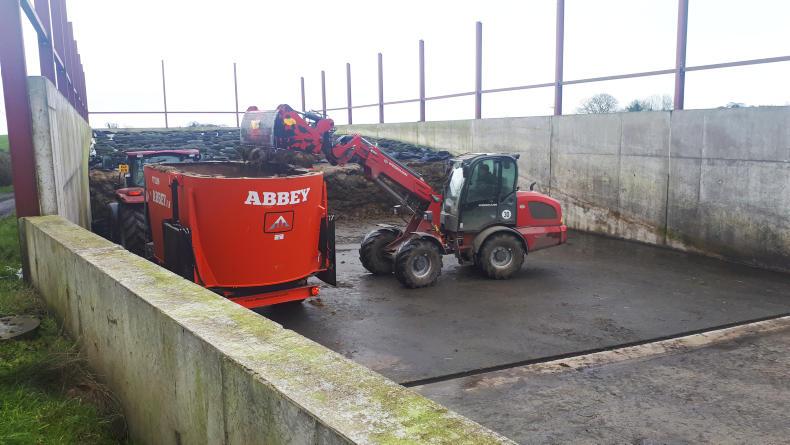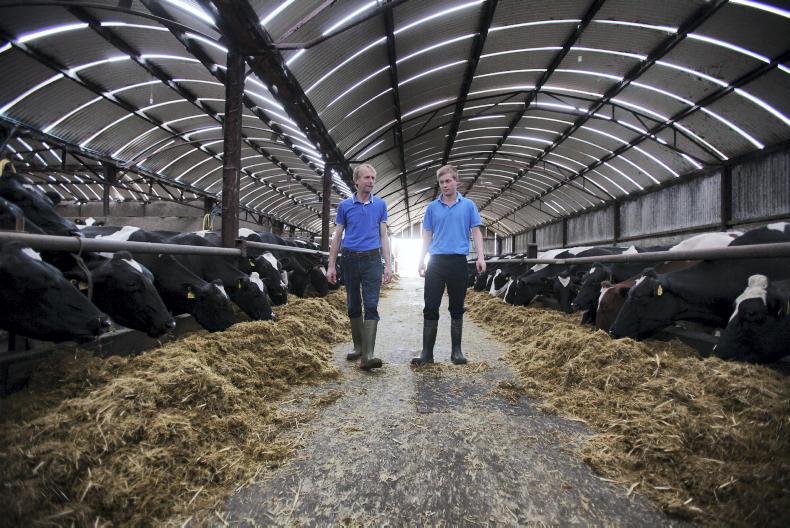The merry-go-round of cows indoors on high-quality expensive feed with farmers having no choice but to keep the best diet in front of high-producing cows is typical of the diagnosis.
For some farmers there is little choice as maybe stocking rates are high or land area for grazing is small, wet and fragmented.
For others who have the resources, they don’t know where to start on managing grass and just work hard from one season to another, locked into what they believe is repeatable even if it is a low margin.
The need to keep slurry tanks emptied and silage in front of cows means there is always work to complete.
Whether it’s slurry out to get silage growing, or silage into a wagon to optimise intakes there is little time left in the day to get paddocks set up for grazing.
Often there isn’t enough head space for the farmer to develop an alternative feed plan. The workload means a grazing opportunity like we have had in February often gets missed or indeed the infrastructure (roadways and fencing) is not present to make use of the chance to graze.
Richard Marshall, farming near Omagh, Co Tyrone, with his parents is one young farmer willing to put his hand up to look at an alternative. He recognises that maybe grass can play a bigger part even for winter milk producing herds.
This week he has 40 cows out grazing during the day. He has the land area, and ground conditions are good.
Small steps, large gains
These are baby steps to learning about grazing, but a number of small steps can make large gains.
More importantly, he is showing a willingness to work with Dairylink adviser Conail Keown who walked the farm with Richard two weeks ago to draw up a plan.
The result of that walk was to get urea, slurry and cows out. The cows that are now out grazing calved in August and September and are scanned back in calf.
They are going into paddocks with covers of about 1,000kg of grass available. If the weather stays dry, more paddocks may be ready for grazing this week.
So what is the benefit? I can hear some Northern farmers saying getting 40 cows out is more hassle than it’s worth.
For Richard, it means less slurry collected, less time spent feeding, cows out on better-quality feed, cows off cubicles reducing indoor workload and less silage used so less requirement to replace it in the pit.
Richard has his high-yielders and lower yielders split in the shed for feeding. The high-yielders typically are on 7.5kg of an 18% protein nut in the blend with 0.75kg of straw nuts, 125g of meaglac, 100g of equaliser and this is mixed with 37kg per head of first-cut silage (33% DM, 16%P, 11.8ME).
Any cows in this group milking over 26 litres get 0.45kg of nuts in the parlour per kg of milk.
This herd contains the cows Richard purchased replacing cows that had to be removed with TB.
The lower yielders (longer milking) were on 2kg of nuts with 41kg per head of silage so the saving on silage is less feed into these cows as they are out on grass.
Great moves
Richard has made some great moves this spring already. The whole farm has been mapped so now he knows what area is in each paddock.
A plan has been drawn up to improve roadway access. Urea has been spread to get grass moving.
Richard is re-considering the option of bringing sheep on to the grazing block to clean off paddocks in autumn and winter. Slurry has been spread on paddocks low in phosphorus and potassium based on soil results.
Richard is getting more and more into measurement with every farm walk. These are all basic steps but are very worthwhile.
Fair play to Richard after what has been a very difficult year for this farm business when TB restrictions take hold.
Farmer Focus: Richard Marshall, Omagh, Co Tyrone
There are 40 cows out daytime grazing on farm. These cows calved in August and September and have been scanned back in calf.
Cows are going into grass covers of 2,400kg to 2,500kg (1,000kg available) on the driest paddocks on the farm.

Richard Marshall has autumn calving cows out grazing so less silage feeding required and less need to replace silage taken out of the pit.
Grazeout is not great as these cows are still getting silage and parlour nuts (18% protein nut).
The rate of parlour feeding is 0.45kg concentrate for each litre above 17 litres. It is proving difficult to get appetite on cows prior to turnout after morning milking so less silage is required.
Richard can see big savings on silage used on a daily basis. A half-bag per acre of urea has been spread on all grazing land.
About 3,000 gal of slurry was spread on 20% of the grazing block using an umbilical spreader and all silage area received the same.
The plan is to walk the farm and get the figures up on the grass software package.
Currently only cows scanned in calf are going to grass, however good conditions on farm might see more cows out. A grass cover figure is needed to make this decision. Cows are producing 30 litres per day at 4.05% butterfat and 3.22% protein. Total feed going in is 9.5kg/cow.
Read more
Watch: addressing issues from soil analysis results
The merry-go-round of cows indoors on high-quality expensive feed with farmers having no choice but to keep the best diet in front of high-producing cows is typical of the diagnosis.
For some farmers there is little choice as maybe stocking rates are high or land area for grazing is small, wet and fragmented.
For others who have the resources, they don’t know where to start on managing grass and just work hard from one season to another, locked into what they believe is repeatable even if it is a low margin.
The need to keep slurry tanks emptied and silage in front of cows means there is always work to complete.
Whether it’s slurry out to get silage growing, or silage into a wagon to optimise intakes there is little time left in the day to get paddocks set up for grazing.
Often there isn’t enough head space for the farmer to develop an alternative feed plan. The workload means a grazing opportunity like we have had in February often gets missed or indeed the infrastructure (roadways and fencing) is not present to make use of the chance to graze.
Richard Marshall, farming near Omagh, Co Tyrone, with his parents is one young farmer willing to put his hand up to look at an alternative. He recognises that maybe grass can play a bigger part even for winter milk producing herds.
This week he has 40 cows out grazing during the day. He has the land area, and ground conditions are good.
Small steps, large gains
These are baby steps to learning about grazing, but a number of small steps can make large gains.
More importantly, he is showing a willingness to work with Dairylink adviser Conail Keown who walked the farm with Richard two weeks ago to draw up a plan.
The result of that walk was to get urea, slurry and cows out. The cows that are now out grazing calved in August and September and are scanned back in calf.
They are going into paddocks with covers of about 1,000kg of grass available. If the weather stays dry, more paddocks may be ready for grazing this week.
So what is the benefit? I can hear some Northern farmers saying getting 40 cows out is more hassle than it’s worth.
For Richard, it means less slurry collected, less time spent feeding, cows out on better-quality feed, cows off cubicles reducing indoor workload and less silage used so less requirement to replace it in the pit.
Richard has his high-yielders and lower yielders split in the shed for feeding. The high-yielders typically are on 7.5kg of an 18% protein nut in the blend with 0.75kg of straw nuts, 125g of meaglac, 100g of equaliser and this is mixed with 37kg per head of first-cut silage (33% DM, 16%P, 11.8ME).
Any cows in this group milking over 26 litres get 0.45kg of nuts in the parlour per kg of milk.
This herd contains the cows Richard purchased replacing cows that had to be removed with TB.
The lower yielders (longer milking) were on 2kg of nuts with 41kg per head of silage so the saving on silage is less feed into these cows as they are out on grass.
Great moves
Richard has made some great moves this spring already. The whole farm has been mapped so now he knows what area is in each paddock.
A plan has been drawn up to improve roadway access. Urea has been spread to get grass moving.
Richard is re-considering the option of bringing sheep on to the grazing block to clean off paddocks in autumn and winter. Slurry has been spread on paddocks low in phosphorus and potassium based on soil results.
Richard is getting more and more into measurement with every farm walk. These are all basic steps but are very worthwhile.
Fair play to Richard after what has been a very difficult year for this farm business when TB restrictions take hold.
Farmer Focus: Richard Marshall, Omagh, Co Tyrone
There are 40 cows out daytime grazing on farm. These cows calved in August and September and have been scanned back in calf.
Cows are going into grass covers of 2,400kg to 2,500kg (1,000kg available) on the driest paddocks on the farm.

Richard Marshall has autumn calving cows out grazing so less silage feeding required and less need to replace silage taken out of the pit.
Grazeout is not great as these cows are still getting silage and parlour nuts (18% protein nut).
The rate of parlour feeding is 0.45kg concentrate for each litre above 17 litres. It is proving difficult to get appetite on cows prior to turnout after morning milking so less silage is required.
Richard can see big savings on silage used on a daily basis. A half-bag per acre of urea has been spread on all grazing land.
About 3,000 gal of slurry was spread on 20% of the grazing block using an umbilical spreader and all silage area received the same.
The plan is to walk the farm and get the figures up on the grass software package.
Currently only cows scanned in calf are going to grass, however good conditions on farm might see more cows out. A grass cover figure is needed to make this decision. Cows are producing 30 litres per day at 4.05% butterfat and 3.22% protein. Total feed going in is 9.5kg/cow.
Read more
Watch: addressing issues from soil analysis results







 This is a subscriber-only article
This is a subscriber-only article










SHARING OPTIONS: